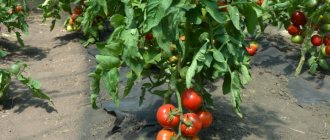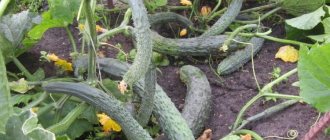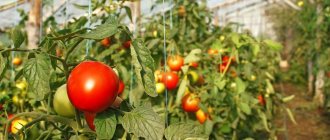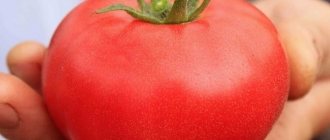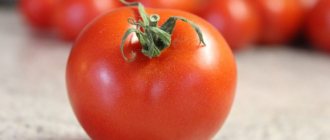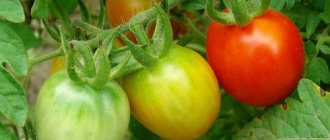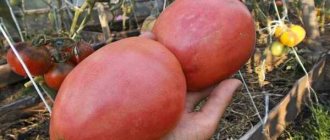Features of the variety
Description and characteristics of the Kukla tomato variety:
- early maturation;
- the period from the appearance of sprouts to harvesting of fruits takes 85-95 days;
- determinate bush;
- height 70 cm;
- medium sized leaves.
The fruits of the Kukla variety have a number of features:
- weight 250-400 g;
- pink color;
- classic round, slightly flattened shape;
- sweet taste due to sugar content (up to 7%);
- 4-6 seed chambers;
- dense, fleshy pulp.
The yield per square meter of plantings of the Kukla variety is 8-9 kg. The fruits tolerate transportation well and are stored for a long time.
The variety has universal application. The fruits are included in the daily diet and salads, snacks, sauces, first and second courses are prepared on their basis. Kukla tomatoes tolerate heat treatment and are suitable for whole-fruit canning.
Specifics of growing tomato Doll F1 with reviews
Reading time: 7 minutes
Breeders work every day to develop resistant and productive varieties of tomatoes. Today, the tomato variety Kukla f1 is quite popular, reviews of which speak of the exceptional qualities of this hybrid. This crop is easy to care for and is one of the ten best varieties for growing in greenhouses. First generation hybrids are used everywhere, since such plants are better adapted to unfavorable climatic conditions.
Description and characteristics of the variety
The tomato variety Kukla f1 is characterized by early ripening and belongs to the productive and persistent determinant type. The Kukla Dasha tomato was bred on the basis of this variety - they are similar in appearance, but differ in taste. The first fruits can be obtained already on the 85th day. The tomato bush is low-growing, the height of the stems reaches 70 cm. A plant with small leaves and moderate foliage. The tomato hybrid was developed by domestic agro. Productivity per 1 sq. m. is up to 9 kg. The weight of the fruit reaches 350 g, the tomatoes are pink in color, round in shape, the flesh is dense and fleshy. A distinctive feature is the high sugar content. Tomatoes Doll f1 have universal use, and they can also be grown in open and closed ground.
The main pros and cons of the tomato Doll F1
Kukla tomatoes are a productive and early ripening variety with good immune protection. O indicates that the variety belongs to the first generation hybrids. Based on this, the plant has a lot of undoubted advantages:
- flower clusters appear early;
- since the fruits ripen quite quickly, this reduces the risk of late blight;
- the harvest gives excellent results at the same time;
- the hybrid can be grown both in open ground and in a greenhouse;
- fruits contain large amounts of sugar;
- tomatoes are used for salads and canning;
- tomatoes tolerate transportation and long-term storage well;
- fruits do not crack during heat treatment;
- strong seedlings and high immunity;
- germination rate up to 98%.
Obtaining seedlings
Tomato Doll is grown in seedlings. First, the seeds are planted at home. After germination, the tomatoes are provided with the necessary conditions. The Kukla variety is planted in beds under the open sky or under cover.
Planting seeds
According to reviews, Kukla F1 tomatoes are planted in February or March. It is taken into account that before planting in the ground, the age of the seedlings should be 1.5-2 months.
To plant the Kukla variety, prepare soil consisting of equal amounts of humus and garden soil. It is allowed to plant tomatoes in purchased soil or peat tablets.
Important! Garden soil is heated in an oven or microwave oven. To disinfect it, you can pour it with a solution of potassium permanganate.
Seeds of the Kukla variety need treatment to stimulate their germination. To do this, the material is placed in warm water for 2 days or wrapped in a moistened cloth. You can add 2-3 drops of any growth stimulant to the water.
If the seeds are coated and have a bright color, then no processing is carried out. Due to the nutrient shell, the sprouts will receive the substances necessary for development.
Advice! To plant Kukla tomatoes you need boxes or individual cups 15 cm high.
Seeds are placed in containers every 2 cm. 2-3 seeds are placed in cups, after germination of which the strongest plant is left.
Cover the top of the container with film. Sprouts appear when containers are kept warm and dark. Then they are moved to a windowsill or other place with good lighting.
Conditions for seedlings
After germination, Kukla tomatoes are provided with certain conditions. The daytime temperature in the room should remain between 20-26°C. At night it is maintained at 10-15°C.
Advice! Tomatoes require light for half a day. If necessary, install lighting fixtures.
Plants are watered as the soil dries. The first watering is carried out when sprouts appear, after 2 weeks the moisture is reapplied. Warm water is used for irrigation.
If Kukla tomatoes were planted in boxes, then when they have 2 leaves, you need to pick them. Plants are transplanted into containers measuring 10x10 cm, filled with the same soil as when planting seeds. For picking, choose the strongest tomatoes.
14 days before transferring tomatoes to a permanent place of cultivation, they need to be hardened off. The procedure will allow plants to quickly adapt to external conditions. First, the containers with tomatoes are left for 2 hours on the balcony or loggia. Gradually, the period of their stay in the fresh air is increased.
Growing rules
To grow high-quality plants and get a good harvest, you must follow the rules of sowing and caring for seedlings.
Find out what diseases tomato seedlings are exposed to and what to do about it.
Growing seedlings
To obtain high-quality seedlings, follow the following sequence of actions:
- Sowing seeds for seedlings is carried out immediately after purchasing the seed material; they do not require pre-treatment, since they are hybrid and undergo all stimulating procedures before they go on sale.
- Large shallow containers are prepared for sowing. Soil marked “For vegetable crops” is purchased in a store or prepared independently: for this, mix 1 part turf soil, 1 part chernozem, 1 part humus or compost, 0.5 parts sand.
- Expanded clay is poured onto the bottom of the container so that excess water drains away in time after watering. Such measures are necessary to avoid possible rotting of the root system and the development of fungal diseases of the roots.
- A layer of soil is poured on top of the expanded clay, and shallow furrows (1 cm) are made with a thin stick. Tomato seeds are placed in the furrows at a distance of 3 cm from each other. Cover with the remaining soil and irrigate with water at room temperature from a spray bottle.
- The containers are covered with plastic film in order to maintain the necessary humidity inside and create a “greenhouse effect” that will stimulate seed germination. The crops are regularly ventilated by removing the film for 1 hour.
- The crops are placed on a well-lit, warm (with a temperature of at least +25°C) windowsill and sprayed once every 2 days.
Video: Sowing tomato seeds for seedlings
Care after seed germination:
- When the first shoots appear, the film is finally removed.
- The air temperature in the room is reduced to +19°C during the daytime and +15°C at night to avoid stretching and thinning of the main stem of the plant.
- Watering after germination can be done at the root using high-quality settled water at room temperature. It is necessary to water as the top layer of soil dries, approximately once every 3-4 days.
- A prerequisite for obtaining strong, healthy seedlings is picking. The procedure is carried out on an already mature plant, when it has at least 2 true leaves. Picking consists of freeing the root system from the earthen coma and removing part of the central root. Picking is done manually with your fingers, while the root is pinched off 0.5–1 cm. Picking stimulates the growth of lateral roots, due to which a strong root system is formed, the stem thickens, and the seedlings become stronger.
- Picked plants are planted in separate containers, preferably peat cups, which can be planted in open ground without damaging the root system of the seedlings. The soil is used of the same composition as for sowing seeds. After planting, the seedlings are well watered at the root and placed in a sunny place.
- Subsequent care continues until the plants are planted in open ground. A week before transplanting, the seedlings begin to harden by taking them outside for 1 hour, gradually increasing the amount of time.
Preparing the site for planting
The area for planting seedlings is chosen to be well-lit and ventilated, without drafts. Light, nutritious soil with a neutral reaction is well suited for growing tomatoes. For planting, choose a place where cucumbers, garlic, cabbage, and onions previously grew.
Important! You cannot plant in a place where potatoes and eggplants previously grew, as the risk of seedlings becoming infected with diseases and pests that affected nightshade crops in the previous year increases.
Soil preparation consists of preliminary digging up the site, removing weeds, and loosening the soil. It would be useful to add rotted manure or compost to enrich the soil with nutrients that tomatoes need to form ovaries and obtain a large harvest. It is enough to add 5–7 kg of organic matter per 1 m².
Technology of planting seedlings in open ground
Planting tomato seedlings is done as follows:
- The holes are prepared; their depth should correspond to the length of the root system of the seedlings. The width between the holes is at least 70 cm.
- Pour 0.5 liters of water into the prepared hole and mix with soil. Place the plants in the holes and fix them with damp soil, then sprinkle with the rest of the soil.
- The soil is lightly compacted to firmly fix the seedlings.
- Overgrown seedlings are planted at a slight angle (45°) to the soil; for this purpose, the plant is specially placed in the holes “crookedly”. Over time, the root system of the plants deepens and the bush levels out.
Planting tomatoes
Tomatoes that have reached a height of 30 cm should be planted in beds. Such seedlings have a developed root system and 5-6 formed leaves. Before carrying out work, you need to make sure that the air and soil have warmed up sufficiently.
Tomatoes are planted in beds where cucumbers, onions, melons and legumes, garlic, and green manure previously grew. Planting after tomatoes of any variety, peppers, eggplants and potatoes is not carried out.
Advice! Beds for Doll tomatoes are placed in lighted areas.
The soil for Kukla tomatoes is prepared at the end of the season. It is dug up and fertilized with compost. Poor soils are fertilized with superphosphate and potassium sulphide (3 tablespoons per square meter). The quality of clay soil is improved by adding sawdust and peat.
In spring, deep loosening of the soil is performed. Doll tomatoes are placed in increments of 40 cm. When organizing several rows, a distance of 50 cm is maintained between them.
The plants are transferred to a new location in holes with a lump of earth. The roots of the tomatoes are covered with soil, after which the surface is slightly compacted. Tomatoes are watered generously and tied to a support.
How to grow
Tomatoes are grown in northern latitudes in greenhouses. They are planted as seedlings from sprouted seeds. Therefore, around April, they begin to sow seeds in containers. Seedlings are planted in the soil in May-June, when the ground is warm and there are no longer frosts at night. The soil in greenhouses must first be dug up and provided with fertilizers.
Watering is necessary before planting. While adaptation is taking place, it is better to leave the tomatoes alone, and after ten days, water them again, loosen the soil and feed them. Watering should be at the root, not on the foliage. The foliage is lightly sprayed.
The very first harvest is obtained at the end of July. The fruits grow almost simultaneously, ideally they are even, the same size and bright pink in color.
Let's look at how to grow tomatoes Doll Masha. Seeds need to be planted in the spring so that they germinate in a timely manner. Before planting seeds for seedlings, they are treated with potassium permanganate. Then they need to be soaked in a container with water for 16-17 days. Before planting, the soil must be loosened and watered.
When the seedlings have several leaves, they begin to water them abundantly. Then the sprouts are picked and each transplanted into a separate container. Strong shoots need to be hardened off. To do this, the seedlings must be taken outside for a while. In early June, tomatoes are planted in the ground. In this case, the sprout should have 10 leaves and an ovary.
Doll Masha tomatoes are grown only in a greenhouse. Plants need to be looked after, watered in a timely manner, loosened the soil, weeded, and mineral and organic fertilizers applied. To increase the yield of tomatoes, growth stimulants can be used. The plant is treated with drugs that are sold in specialized stores. Use them according to the instructions.
Tomatoes are consumed fresh, for making salads, juices, tomato paste, ketchups, and side dishes. Whole-fruit canning is made from small-sized fruits.
Tomatoes are grown using the seedling method. Sowing is carried out 1.5-2 months before transplanting into the ground. Before doing this, pay attention to whether the seeds have been treated against pests and diseases by the manufacturer. This is indicated by the coating with colored granules.
If there is no treatment, the seeds are soaked in warm water for 30 minutes, wrapped in a damp cloth and left until they hatch.
We suggest you read How to make adjika with horseradish and tomatoes
Obtaining seedlings
Sprouted seeds are planted in prepared soil, purchased in a store or prepared independently. The composition of loose and nutritious soil includes turf soil, sand, compost, black soil in a ratio of 2:1:1:1.
The bottom of the containers is drilled, a layer of drainage is poured and filled with ready-made soil. Do not fill the container completely, leave 2 cm to the edges. The soil is disinfected by pouring boiling water or a solution of potassium permanganate. The seeds are planted to a depth of 1 cm, maintaining a distance between them of up to 3 cm. They are covered with earth, watered and covered with film or glass. This will maintain optimal humidity and the seeds will germinate faster.
With the appearance of the first shoots, the shelter is removed, the container with young seedlings is moved to a lighted place. The temperature should not exceed 16 °C. Picking into individual containers is carried out when the first 2 leaves appear. In order for the root system to strengthen and form, the seedlings are buried in the soil.
2 weeks before planting in the soil, the prepared seedlings are hardened off: they are taken out into the fresh air every day, gradually increasing the time they spend outside. At the time of planting, the bushes should be outside all day.
Seedlings are transplanted to a permanent location at two months of age, when the plant height reaches 30 cm and there are up to 6 leaves on the stem. Replant together with a lump of earth.
Watering and care
They get a generous and tasty harvest with proper care of the hybrid:
- To ensure rapid fruit ripening, shoots are regularly planted.
- Tomatoes are fed with complex fertilizers.
- Particular attention is paid to watering: The doll does not tolerate cold water, so the liquid is warmed up in the sun during the day, and the soil is moistened in the evening. Water the bushes at the roots.
- The beds are regularly weeded no deeper than 10 cm: weeds should not choke the tomato stems. To reduce the frequency of weeding, the ground is mulched with straw, sawdust or peat. Periodically loosen the soil.
- Avoid the proximity of the crop to eggplants and peppers, especially bitter varieties.
- When the bushes reach a height of 1 m, they are tied up.
Caring for a hybrid is simple, but requires systematic and thorough care.
Variety care
Kukla variety tomatoes require constant care. This includes watering, saturating plants with nutrients and loosening the soil.
According to the description and reviews, the Kukla tomato can be shaped, which allows for increased fruiting. In tomatoes, shoots growing from the leaf axil are pinched. Their development thickens the plantings and takes away the strength of the plants.
Watering tomatoes
Doll tomatoes are watered once or several times a week, taking into account their stage of development. It is best to add moisture rarely, but plentifully.
Procedure for watering tomatoes:
- before fruit formation, apply up to 5 liters per bush weekly;
- When fruiting, use 3 liters of water for each plant every 3 days.
The need to add moisture is indicated by wilting and curling of the tomato tops. During the fruiting period, the intensity of watering is reduced when the fruits crack. Excess moisture negatively affects the development of tomatoes and leads to the spread of late blight and other diseases.
To water Kukla tomatoes, warm water is required. It is defended in containers that are placed in greenhouses or in the sun. Watering is carried out in the morning or evening hours, when there is no direct sunlight.
After watering, loosen the soil. The procedure provides oxygen access to the roots and improves nutrient absorption.
Fertilizer application
The application of fertilizers helps to increase the yield of the Kukla variety. It is allowed to use both mineral substances and folk remedies.
21 days after planting the tomatoes, they are fed with Nitrophoska solution. This is a complex fertilizer that saturates tomatoes with nitrogen, potassium and phosphorus. Add a teaspoon of fertilizer to a bucket of water. The product is applied at the root of plants.
Advice! For the second feeding, take superphosphate and potassium salt (30 g per large bucket of water).
Fertilizers are reapplied after the next 2 weeks. Instead of minerals, wood ash is used. An infusion is prepared on its basis, which is added to the water when watering.
To speed up ripening, Kukla tomatoes are watered with a solution of humates. Add 1 tbsp to a bucket of water. l. fertilizers Fertilizer is applied at the root when watering.
Advantages and disadvantages
- Among the advantages of the Kukla F1 variety are:
- high yield rates;
- good taste and attractive appearance of the fruit;
- versatility of using tomatoes;
- good transportability without loss of quality characteristics;
- strong seedlings and vitality of young plants;
- resistance to common diseases;
- possibility of cultivation in open ground and in greenhouses;
- ease of plant care due to the compactness and small size of the bushes.
- The disadvantages of the variety include:
- the unsuitability of personally collected seeds for propagation and planting them next year, since they do not retain maternal qualities;
- deterioration in the quality of fruiting due to untimely watering of plants;
- the need to tie up the bushes, as they tend to sag to the ground under the weight of the fruit.
Did you know? The largest tomato, according to the Guinness Book of Records, is a fruit grown in the USA (Wisconsin), which weighed 2.9 kg.
Good feedback
- firstly, this variety can only be grown in a greenhouse or warm greenhouse;
- secondly, the hybrid has its own watering requirements;
- thirdly, the plant requires a lot of light, which means it always needs additional lighting, especially on cloudy days.
Despite some nuances that slightly spoil the overall impression of the Kukla Masha tomatoes, this variety among its “relatives” is especially popular and loved by gardeners. How can you resist the temptation from the garden to taste this fruit with its unusual taste and unique aroma! It is not without reason that it is believed that tomatoes contain serotonin - the “happiness hormone”, by consuming which people can easily get rid of a bad mood and, perhaps, become momentarily happier.
Protection from diseases and pests
According to its description and characteristics, the Kukla tomato variety is resistant to diseases. The development of diseases is provoked by high humidity and improper watering. For additional protection, plants are sprayed with a solution of Fitosporin or another fungicide.
Tomatoes are attacked by aphids, whiteflies, mole crickets and other pests. Insecticides are used to control insects. The most effective folk remedy is to treat plantings with tobacco dust or wood ash. Infusions of onion or garlic peels are good at repelling pests.
Reviews about my Doll
We have a small garden, and I personally like that the Doll bushes are low and take up little space.
The year before last I didn’t hill them. I’ve already hilled it in the past (a neighbor suggested it - surprisingly, I used to think that only potatoes needed to be hilled). It seems to me that this simple procedure had a good effect on the yield of tomatoes.
Another advantage of the variety I would say is good seed germination. Of course, I don’t rule out that it’s just a coincidence, but for three years in a row I’ve been buying a Doll, and almost all the seeds I’ve sown (give or take a couple of things) turn into bushes. Both my mother and my neighbor, who have been familiar with this variety for a long time, say the same thing.
From last year's harvest I selected the strongest, slightly unripe fruits. I brought it to the city in plastic boxes and placed it in the basement (we have a separate storage room there). The tomatoes successfully survived until November. And then, when many summer residents were already buying vegetables for salads, we still chopped up all our own.
Reviews from gardeners
Maria, 48 years old, Moscow region
Last year, based on the description and reviews, I chose the Kukla tomato for planting on my plot. The seedlings sprouted well and developed without problems. I planted tomatoes in open ground. I liked the variety because it produced an early harvest of large fruits. The height of the bush was 70 cm, which made it very easy to care for.
Victor, 54 years old, Sverdlovsk region
Based on reviews, I bought Doll F1 tomatoes for planting at the dacha, and did not regret it at all. I plant them in a greenhouse to get a high yield. Tomatoes are suitable for canning and making salads. The fruits are strong and tasty and are stored for a long time. We finished eating them already in November. I'll definitely plant it again next year.
Olesya. 32 years old, Penza
Doll bought tomato seeds for the first time 10 years ago. Since then I have grown them every year. I plant them both in the greenhouse and in the open air. The variety brings a good harvest. The fruit tastes sweet and sour, with a characteristic tomato flavor. The appearance is excellent, the tomatoes are large and even. I prepare salads for the winter with them, they turn out very tasty.
Pros and cons of a hybrid
The undoubted advantages of tomatoes:
- Flower clusters are laid early.
- The fruits ripen faster than other varieties and hybrids, which avoids late blight.
- The harvest is distinguished by high volumes and friendly returns.
- The tomato is less susceptible to diseases and is easy to care for.
- The hybrid takes root in open and closed ground.
- The fruits have a sweet taste.
- Tomatoes are universal in use: they are used fresh, canned for the winter, and juices and sauces are prepared from them.
- During storage, the fruits do not crack and are highly transportable.
Despite a number of advantages, the hybrid has minor disadvantages:
- Seeds have to be purchased annually, since the collected material does not retain the quality parameters of the hybrid.
- Low bushes still need staking.
- It is important to water the crop in a timely manner.
- The determinate form does not always suit gardeners, since the bushes stop growing after the formation of ovaries.
The limited growth of the crop does not prevent the advantages from fully manifesting themselves when the hybrid is properly cultivated.
Criteria for selecting tomatoes
When choosing the names of tomatoes, you should focus on the type of crop, in particular, what it is in terms of ripeness and the height (growth) of the bushes.
For example, a distinctive feature of the F1 Doll is its ultra-early maturation and short stature. It is these features that are most appropriate when determining the names of tomatoes for the middle latitude of the Russian Federation. However, what do they mean?
The sign of determinacy in tomatoes indicates the degree of stem elongation. For example, indeterminate plants grow throughout the season without stopping the growth of the stem. At the same time, they can reach a height of as much as two meters. In this connection, pinching is a mandatory principle of care for such plants. Quite a few ovaries are formed on them, but there is no need to talk about their early ripeness.
With the Kukla tomato it’s the other way around - the tomatoes ripen early, the shoots are limited in growth. Late July - August - the bushes delight with their tomatoes, the shoots stop growing in height.
For those vegetable growers who have little experience in gardening and have their own greenhouse, they should start exclusively with determinate tomatoes. For example, such as Doll and Doll Masha, and gradually move on to growing intermediate crops (semi-determinates), in which growth, although intensive, is not strong, like indeterminates.
To enjoy ripe tomatoes at the height of summer, you need to breed ultra-early ripening tomatoes for greenhouses and open ground with a ripening period of mainly up to 90 days.
As an example, we give the most common and early ripening tomato varieties in vegetable growing (the number of days to maturity is indicated in parentheses): Aphrodite (75), Maksimka (75), Marisha (80), Benito (70), Kukla (85). And not hybrids - Parodist (80), Far North (85).
Tomatoes are selected extremely rarely based on such a parameter as the shelf life of tomato seeds. Since in most varieties it does not exceed 5-6 years. Here, more attention is paid to another criterion that applies to seeds - the possibility of independently preparing planting material from tomatoes obtained in your own backyard.
For those vegetable growers who have little experience in gardening and have their own greenhouse, they should start exclusively with determinate tomatoes. For example, such as Doll and Doll Masha, and gradually move on to growing intermediate crops (semi-determinates), in which growth, although intensive, is not strong, like indeterminates.
Time for sowing
The seeds of the variety are sown at the end of March - beginning of April, so that during the period of planting seedlings in open ground, they will grow sufficiently and take root in a new place. Planting of seedlings in a permanent place of growth is carried out after 40 days if it is planned to grow in greenhouse conditions, or after 60 days if the seedlings will grow in an open bed.
